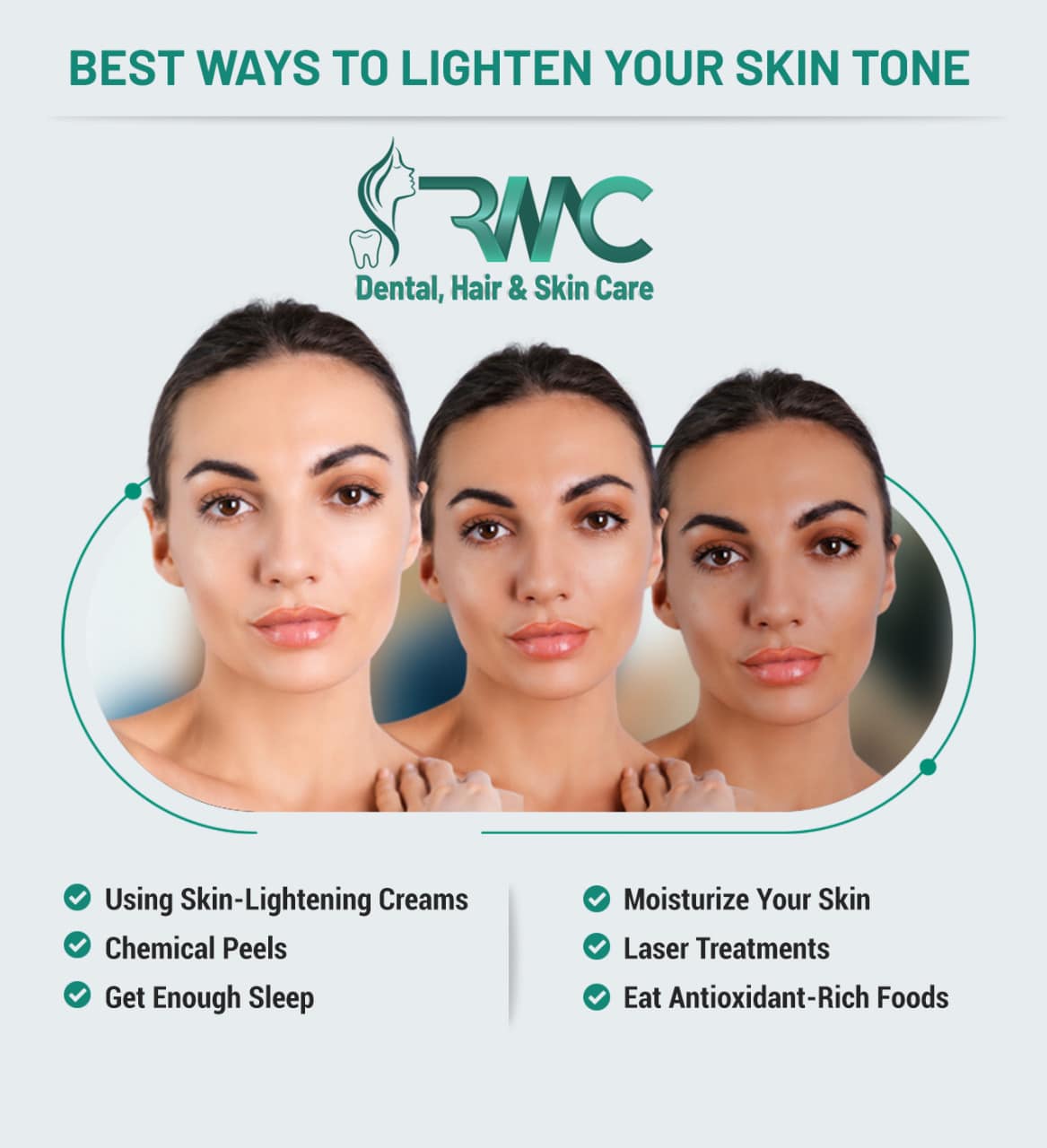How to Lighten Skin Tone?
Dark, dull, and pigmented skin can be caused by various things, including excessive sun exposure, pollution, bad lifestyle choices, underlying medical issues, and even stress. The market is swamped with skin-lightening creams and lotions because many women dream of having fair, beautiful skin.
However, using cosmetics on a regular basis can harm your skin. We provide you with some advice on how to lighten your skin tone naturally and get a flawless appearance.

Ways to Lighten Your Skin Tone
There are a few ways to lighten skin tone, but it’s important to note that you choose the best one according to your skin type. Some of the options for lightening skin tone include:

-
Using Skin-Lightening Creams
These creams can contain ingredients that help to reduce the production of melanin in the skin, which can help to lighten the skin. However, some of these creams can have harmful side effects, so it’s important to talk to a dermatologist before using them.
These creams can contain various ingredients that can help lighten the skin. Some of the ingredients that may be found in skin-lightening creams include:
Hydroquinone: This can help lighten the skin by reducing the production of melanin. However, it can also cause side effects such as redness, itching, and dryness.
Corticosteroids: These steroids can help reduce inflammation and swelling in the skin. However, long-term use of corticosteroids can cause side effects such as thinning of the skin, stretch marks, and acne.
Azelaic Acid: This is a natural acid that can assist in whitening the skin and reducing swelling. Redness and itching are only a couple of the few side effects that it may have.
It’s important to carefully read the label of any skin-lightening cream you’re considering using and follow the instructions on the label. If you have any concerns or questions, it’s best to talk to a dermatologist or other medical professional.
-
Peel Off
Peel Off is a type of skin treatment in which the top layers of skin are removed by applying a solution to the skin. This can assist in enhancing the skin’s tone and texture as well as lessen the visibility of fine wrinkles, uneven skin tone, and acne scars.
There are several different types of peel Off, ranging from mild to deep, and the type of peel that’s best for you will depend on your skin type and concerns. A dermatologist can peel-Off; the procedure usually takes about 30 minutes to an hour.
After a peel Off, the skin will be red and sensitive, and it may peel or flake for a few days or weeks. It’s essential to follow the aftercare instructions provided by the dermatologist to help ensure the best results and minimize the risk of complications.
It’s important to note that peel-Off can cause side effects such as redness, swelling, and scarring, and they may not be suitable for everyone. Talking to a dermatologist or other medical professional is always best before considering a peel-Off.
-
Get Enough Sleep
Your skin and face may suffer if you get less sleep because your body needs 7 to 9 hours of sleep each night. It would be best if you allowed your body plenty of time to rest in order to bring out the inner radiance.
As you sleep, your body improves blood flow to the skin, giving you a radiant complexion when you wake up. However, if you don’t get enough sleep, your skin may look dull and lifeless, and dark circles may start to appear.
-
Moisturize Your Skin
Keeping your skin hydrated helps improve its appearance and gives it a more radiant and healthy-looking tone. A face oil or daily moisturizer can help lock in moisture and keep your skin feeling soft and hydrated.
Here are a few tips for using a face oil or daily moisturizer to hydrate your skin:
Choose a product suited to your skin type: Oils and moisturizers can be made for different skin types, so choosing a product tailored to your needs is important. For example, choose a lightweight, oil-free moisturizer if you have oily skin.
Use it twice a day: Applying your face oil or moisturizer in the morning and at night can help to keep your skin hydrated and nourished throughout the day.
Pay attention to your skin’s needs: If your skin is dry, use a more intense moisturizer or apply face oil before your moisturizer to help lock in extra moisture.
Don’t forget to exfoliate: Exfoliating your skin can help remove dead skin cells and unclog pores, which can help improve your skin’s overall appearance. Just be sure to choose an exfoliator that’s suitable for your skin type.
-
Laser Treatments
The top layers of skin are removed during laser treatments. This can assist in enhancing the skin’s tone and texture as well as lessen the visibility of fine wrinkles, uneven skin tone, and acne scars.
However, it’s important to note that laser treatments can cause side effects such as redness, swelling, and scarring, which may not be suitable for everyone.
Several different types of laser treatments can be used to improve skin tone, including:
Fractional laser treatments: These treatments use a laser to create tiny wounds in the skin, which can stimulate the production of collagen and help to improve the texture and tone of the skin.
Laser resurfacing: This treatment uses a laser to remove the top layers of skin, which can help improve the skin’s texture and tone.
Intense pulsed light (IPL) treatments: These treatments use a broad spectrum of light to improve the tone and texture of the skin.
It’s always best to talk to a dermatologist or other medical professional before considering a laser treatment to determine which treatment is best for you and to discuss the potential risks and benefits.
-
Eat Antioxidant-Rich Foods
Eating a diet rich in antioxidants can be beneficial for your overall health and may also help improve your skin’s appearance. Antioxidants are substances that can assist in defending your cells against damage brought on by free radicals, unstable molecules that can destroy the tissues in your body.
Many foods are high in antioxidants, including:
Fruits and vegetables: Berries, such as strawberries, raspberries, and blueberries, are particularly high in antioxidants. Other good sources of antioxidants include leafy green vegetables, such as spinach, kale, and vegetables like bell peppers, tomatoes, and squash.
Nuts and seeds: Nuts and seeds, such as almonds, walnuts, and chia seeds, are also high in antioxidants.
Whole grains: Whole grains, such as oats and quinoa, are a good source of antioxidants.
Green tea: Green tea is a good source of antioxidants, and it also contains other beneficial compounds, such as catechins, which can help to protect your skin from damage caused by the sun.
By incorporating more antioxidant-rich foods into your diet, you can help support your overall health and may also improve your skin’s appearance.
Final Thoughts
Prevention is preferable to treatment when it comes to lightening your skin. To stop your skin tone or blemishes from darkening, emphasize sun protection, exfoliation, and skin barrier protection.
When you have a preventative strategy, you can concentrate on using the correct products and eating the right foods to lighten your skin tone and address other pigmentation problems.
Before attempting to change your skin tone, it is usually advisable to consult a dermatologist. You can now talk with the experts at Rehman Medical Center. So, book an appointment now.
